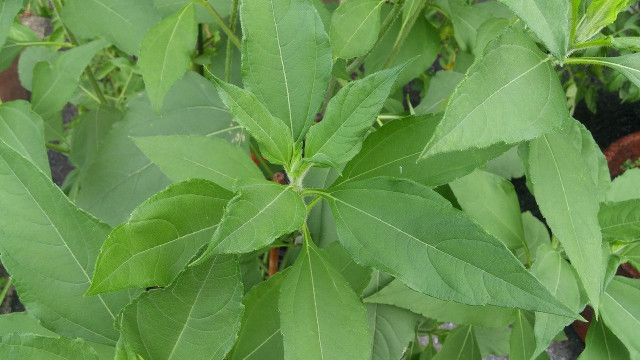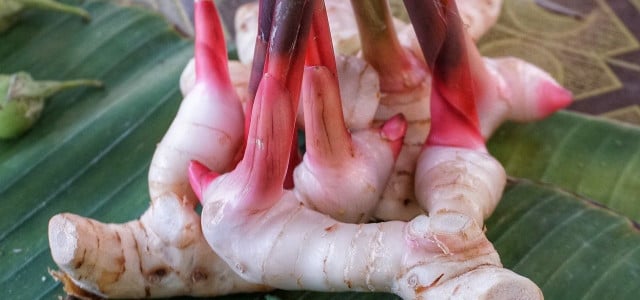Contents
Galangal in the garden

Galangal originates from the Asian region and is mainly cultivated in Thailand and the Chinese island of Hainan. With us, the root is still quite uncommon. Only in well-stocked Asian stores you can buy the tuber.
This is how the cultivation succeeds:
Location:
Galangal needs a bright and warm location. A south-facing windowsill or greenhouse is optimal.
Since temperatures should remain constant throughout the year, galangal is only suitable for cultivation in pots. The pot should be at least 20 inches in diameter.
Soil:
The soil should be nutrient-rich and permeable. The plant is sensitive to waterlogging. A layer of expanded clay or gravel in the bottom of the pot can help to drain water better.
Planting:
To grow galangal, all you need is a fresh piece of galangal. Leave it in a bright place for a few days until the root begins to sprout.
Place it in loose soil and cover it with about two inches of soil.
Care:
Galangal needs a lot of liquid. During the growing season, you should water the plant daily. However, avoid waterlogging, otherwise the roots will quickly begin to rot.
In addition, spray the leaves regularly with a little water.
In order for the tubers to form well, the plant needs sufficient nutrients. For this purpose, it is best to use organic fertilizer at intervals of two months.

Galangal is related to ginger and also forms underground tubers. Galangal is a popular spice and medicinal plant, especially in Asia. Here you can learn how galangal works and how to use the root.
Galangal is an Asian spice plant that is closely related to ginger. Just like ginger, the plant forms underground tubers that are used in cooking.
In this context, galangal refers to different plants:
- True galangal (Alpinia officinarum).
- Greater galangal (Alpinia galanga)
- Lesser galangal (Kaempferia galanga)
The above-mentioned species all form tubers, which are mainly used in Asian cuisine and are valued as a medicinal plant. The ingredients are predominantly identical. Often galangal is also called Thai ginger.
In the following article you will learn how galangal works, how to use the tuber and how to grow it in your garden.
How galangal works

Especially in Asian medicine, galangal has a long tradition. Both the fresh tuber, as well as dried and then ground into a fine powder galangal are considered a remedy.
But also in the European area galangal has long been used for health purposes. Hildegard von Bingen was already convinced of the root. She used galangal especially for problems with the heart, but also recommended for the stomach and gall bladder and treated fever with it.
The effect of galangal has now been extensively scientifically studied. For example, in 2015, the Journal of Botanical Sciences looked at the ingredients and effects of galangal in a study and was able to demonstrate the following properties:
- antimicrobial: In the laboratory, galangal has proven to be efficient against various strains of bacteria as well as fungi.
- antioxidant: The ingredients of galangal have a strong antioxidant effect. They protect the body from oxidative stress, support cell renewal and fight free radicals.
- anti-carcinogenic: In animal studies on rats and mice, galangal has been shown to be effective in both preventing and treating tumors. Preliminary studies in humans have also shown that galangal reduces the spread of cancer cells.
- anti-inflammatory: Galangal helps with inflammation and is therefore used in inflammatory skin diseases, such as rheumatism or arthritis.
- cholesterol-lowering: In studies on rats, galangal was able to noticeably lower cholesterol levels after only four weeks.
Galangal in the kitchen

Galangal is reminiscent of ginger both visually and in taste. However, the galangal root is somewhat milder and brings a slightly bitter taste, as well as a fresh citrus note. The smell of galangal is reminiscent of pine forest.
To refine your dishes with galangal, you can either finely chop or grate the tuber. Besides the fresh tuber, you can also use galangal dried in the form of powder. If you bought the tuber in organic quality, you can use the peel without hesitation. Otherwise, it is better to peel galangal.
If you use galangal raw or add the spice just before serving, the root tastes rather spicy. The longer you cook it, the milder the taste.
Basically, you can distinguish the different types of galangal by their color:
- white to yellow: The light variety has a much milder taste and is suitable for a variety of dishes.
- reddish: The red root is spicier and has a more bitter taste. Here you should be careful and use less, so that the taste does not dominate too strongly.
Just like ginger, you can use galangal in a variety of ways in cooking:
- Soups: Galangal adds special spice to Asian soups, such as the Thai coconut milk soup Tom Kha.
- Stir-fry: Whether vegetables or rice dishes – galangal adds an exotic touch to stir-fry dishes. Meat and fish can also benefit from the fine spice of galangal.
- Stews and curries: Galangal is an integral part of curries, especially in Thai cuisine.
- Desserts: Many Asian desserts rely on the mild spiciness of galangal. For example, you can add galangal to Asian rice pudding. But European classics like rice pudding also get a new depth from galangal, cardamom and cloves.


